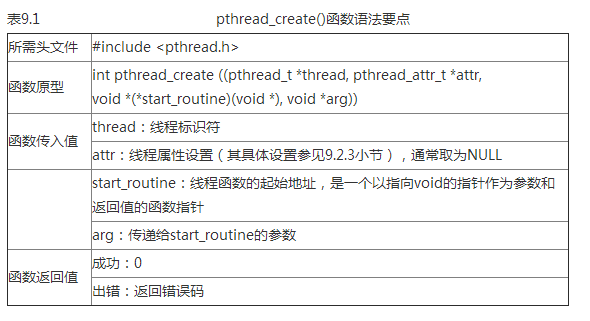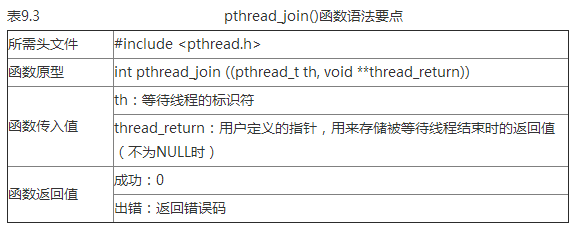多线程编程之:Linux线程编程
9.2 Linux线程编程
9.2.1 线程基本编程
这里要讲的线程相关操作都是用户空间中的线程的操作。在Linux中,一般pthread线程库是一套通用的线程库,是由POSIX提出的,因此具有很好的可移植性。
(1)函数说明。
创建线程实际上就是确定调用该线程函数的入口点,这里通常使用的函数是pthread_create()。在线程创建以后,就开始运行相关的线程函数,在该函数运行完之后,该线程也就退出了,这也是线程退出一种方法。另一种退出线程的方法是使用函数pthread_exit(),这是线程的主动行为。这里要注意的是,在使用线程函数时,不能随意使用exit()退出函数进行出错处理,由于exit()的作用是使调用进程终止,往往一个进程包含多个线程,因此,在使用exit()之后,该进程中的所有线程都终止了。因此,在线程中就可以使用pthread_exit()来代替进程中的exit()。
由于一个进程中的多个线程是共享数据段的,因此通常在线程退出之后,退出线程所占用的资源并不会随着线程的终止而得到释放。正如进程之间可以用wait()系统调用来同步终止并释放资源一样,线程之间也有类似机制,那就是pthread_join()函数。pthread_join()可以用于将当前线程挂起来等待线程的结束。这个函数是一个线程阻塞的函数,调用它的函数将一直等待到被等待的线程结束为止,当函数返回时,被等待线程的资源就被收回。
前面已提到线程调用pthread_exit()函数主动终止自身线程。但是在很多线程应用中,经常会遇到在别的线程中要终止另一个线程的执行的问题。此时调用pthread_cancel()函数实现这种功能,但在被取消的线程的内部需要调用pthread_setcancel()函数和pthread_setcanceltype()函数设置自己的取消状态,例如被取消的线程接收到另一个线程的取消请求之后,是接受还是忽略这个请求;如果接受,是立刻进行终止操作还是等待某个函数的调用等。
(2)函数格式。
表9.1列出了pthread_create()函数的语法要点。
表9.2列出了pthread_exit()函数的语法要点。
表9.3列出了pthread_join()函数的语法要点。
表9.4列出了pthread_cancel()函数的语法要点。
(3)函数使用。
以下实例中创建了3个线程,为了更好地描述线程之间的并行执行,让3个线程重用同一个执行函数。每个线程都有5次循环(可以看成5个小任务),每次循环之间会随机等待1~10s的时间,意义在于模拟每个任务的到达时间是随机的,并没有任何特定规律。
/* thread.c */
#include
#include
#include
#define THREAD_NUMBER 3 /*线程数*/
#define REPEAT_NUMBER 5 /*每个线程中的小任务数*/
#define DELAY_TIME_LEVELS 10.0 /*小任务之间的最大时间间隔*/
void *thrd_func(void *arg)
{ /* 线程函数例程 */
int thrd_num = (int)arg;
int delay_time = 0;
int count = 0;
printf("Thread %d is starting\n", thrd_num);
for (count = 0; count < REPEAT_NUMBER; count++)
{
delay_time = (int)(rand() * DELAY_TIME_LEVELS/(RAND_MAX)) + 1;
sleep(delay_time);
printf("\tThread %d: job %d delay = %d\n",
thrd_num, count, delay_time);
}
printf("Thread %d finished\n", thrd_num);
pthread_exit(NULL);
}
int main(void)
{
pthread_t thread[THREAD_NUMBER];
int no = 0, res;
void * thrd_ret;
srand(time(NULL));
for (no = 0; no < THREAD_NUMBER; no++)
{
/* 创建多线程 */
res = pthread_create(&thread[no], NULL, thrd_func, (void*)no);
if (res != 0)
{
printf("Create thread %d failed\n", no);
exit(res);
}
}
printf("Create treads success\n Waiting for threads to finish...\n");
for (no = 0; no < THREAD_NUMBER; no++)
{
/* 等待线程结束 */
res = pthread_join(thread[no], &thrd_ret);
if (!res)
{
printf("Thread %d joined\n", no);
}
else
{
printf("Thread %d join failed\n", no);
}
}
return 0;
}
以下是程序运行结果。可以看出每个线程的运行和结束是独立与并行的。
$ ./thread
Create treads success
Waiting for threads to finish...
Thread 0 is starting
Thread 1 is starting
Thread 2 is starting
Thread 1: job 0 delay = 6
Thread 2: job 0 delay = 6
Thread 0: job 0 delay = 9
Thread 1: job 1 delay = 6
Thread 2: job 1 delay = 8
Thread 0: job 1 delay = 8
Thread 2: job 2 delay = 3
Thread 0: job 2 delay = 3
Threa
- REDIce-Linux--灵活的实时Linux内核(11-12)
- linux文件系统基础(02-09)
- Linux标准趋向统一(11-12)
- linux基础技术(02-09)
- LINUX的目录树(02-09)
- 在Windows下启动Linux(02-09)
